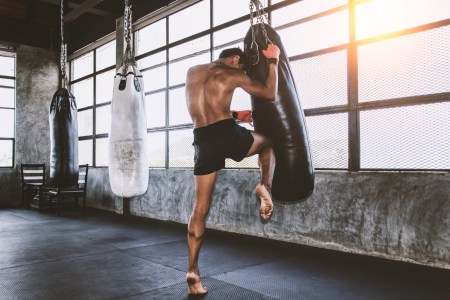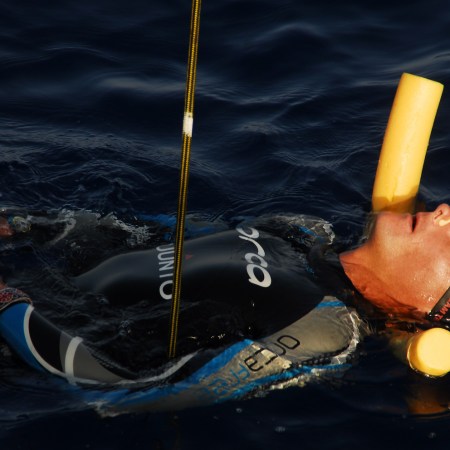If you really want to learn how to surf, you should go to a surf camp. We covered a delightful one in Costa Rica’s Peninsula Papagayo last month, where the offshore winds are robust, barrels are aplenty and fish tacos and watermelon fresca are typically waiting when it’s all over. Not a bad way to spend a day.
But it’s understandable if you’re intimidated — either by the insularity of the surfing community (though they’re not so scary once you get to know them), or by the prospect of so much time spent in the water (which, yeah…the ocean’s pretty dangerous). Some aren’t convinced that they want to surf; they just want a little bit of what surfers have got: The attitude, the clothes, the hair. We’d argue a surfer’s most admirable asset, though, is their fitness.
Surfers are in crazy shape, and it’s a really unique sort of shape: shredded shoulders, strong stabilizers, flexibility in the trunk and lower half, well-developed diaphragms and endurance reservoirs not dissimilar from middle-distance runners. At the first surfing competition I went to, on Oahu’s North Shore, this mix of power, agility and balance was on full display. (As were many a bloodied elbow or knee, on account of violent collisions with the coral.)
In order to attain the shape of someone who surfs every single day, without having to surf, we’ve put together a compendium of five different approachable workouts: swimming, yoga, stand-up paddleboarding, upper-body training and breathwork included.
How to Live Happier, Healthier and Longer With Muay Thai
A beginner’s guide to “the art of eight limbs”Swimming
Believe it or not, surfers only spend 8% of their time on the water catching waves. The rest of the excursion is spent swimming (or waiting). The workout below can easily be performed at your local pool. (Bonus: if you do live near the ocean, try mixing in an open water swim from time to time, too.)
- Warm-up: Swim freestyle for five minutes at an easy pace to warm up your muscles
- Drills: Practice treading water (tread as hard as you can for 30 seconds, then float on your back for 30 seconds, repeat), and dolphin kicking underwater for a total of 10 minutes or so
- Intervals: Alternate between swimming freestyle at a high intensity for one minute and a relaxed pace for one minute. Repeat this “circuit” five times
- Cool-down: Swim at a leisurely pace to relax your muscles and bring your heart rate back down to earth
Yoga
Most surf camps worth their salt have morning and evening yoga sessions on offer. For surfers, yoga is a strengthener and a salve at the same time. Short of committing to a class (or an online class), these are some gentle, introductory moves that pair well with surf-adjacent training. Allocate two minutes for each move outlined below (and in cases that isolate each side, perform two minutes per foot).
- Warrior series: Cycle through Warrior I, II and III to build up your balance
- Downward-facing dog: Another classic. It’ll stretch out your hamstrings and shoulders, while engaging your core
- Tree pose: This one ups the balance ante a bit. Stand on one foot and place the other foot on your inner thigh, then alternate to the other foot
- Pigeon pose: Opens up the hips!
- Seated forward fold: Another one for stretching the hamstrings and low back
- Seated twist: To increase your spinal flexibility and core strength
- Savasana: We recommend ending the sequence with a corpse pose, holding for up to five minutes
Upper-body
It seems antithetical to the surfing spirit to send you to a dark basement gym, so here’s a strength training workout that can be performed pretty much anywhere, with an emphasis on bodyweight movements, manageable loads and lots of reps. (The surfer’s physique is typically more toned than yoked.)
- Warm-up: Perform dynamic stretches such as arm circles, shoulder rolls, and cross-body arm swings to loosen up your upper body. (We’ve got a great wake-up workout here.)
- Push-ups: Surfers typically build up their chests, shoulders and triceps through paddling. Try four sets of 25 push-ups, and use assistance features, if necessary.
- Resistance band seated-rows: These’ll hit the back, which surfers hone by keeping their posture on the board. Loop them around your feet or a bar and pull for three sets of 15 reps.
- Parallel dips: There’s no need to bench press when dips still exist. Just another great way to build up the chest. Try three sets of 10 reps each.
- Plank variations: Standard plank, side plank on each side, and reverse plank to strengthen your core. Try to get as close to a minute for each. That’s as full-body as it gets, just like operating a board at a moody break.
Stand-Up Paddleboarding
The most “playful” workout here, though SUP is more than a novelty vacation adventure — it’s a comprehensive workout that challenges strength and stability. It’s also a great way to get more comfortable with being out on the open water. For some trainees, then , it’s a potential gateway activity to actual surfing. (FWIW: We’re fans of the offerings on-hand at Body Glove.)
- Warm-up: Paddle at a moderate pace to get your muscles warmed up and heart rate elevated.
- “Paddle intervals”: Alternate between “sprinting” for 30 seconds and paddling at a relaxed pace for 1 minute. Repeat 10 times, and this workout should take around 15 minutes. (Suffice to say, it’s nice to have some sort of lake nearby.)
- Balance drills: Alternate single-leg squats (five reps to a leg, three sets total), then finish with a minute-long plank on the board
- Cool-down: Paddle at a leisurely pace to relax your muscles and bring your heart rate back down.
Breathwork
When surfing huge breaks, some surfers can get held down by a wave for a half minute or even longer. A nice pair of triceps won’t save them. The water’s too strong. But trusting in a powerful lung capacity (and staying calm under pressure) gives them a fighting shot. Building lung capacity starts with building the diaphragm, which starts with breathwork. A bonus on breathwork: you should be employing it for stress reduction and cardiovascular fitness, anyway.
- Diaphragmatic breathing: Rest one hand on your stomach, the other on your chest, and breathe deeply through your nose, filling your lungs from the bottom up. Exhale slowly through your mouth. Take note of how your diaphragm expands and collapses. If you need a playlist to breathe to, we recommend this one.
- Box breathing: Inhale for a count of four, hold your breath for a count of four, exhale for a count of four, and hold your breath for another count of four. Repeat the cycle until you’ve built up a rhythm.
- Apnea training: Inhale deeply, then exhale completely. Hold your breath for as long as you can. Rest, then repeat three more times.
The Charge will help you move better, think clearer and stay in the game longer. Subscribe to our wellness newsletter today.


























